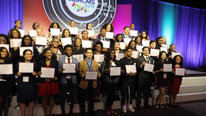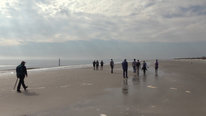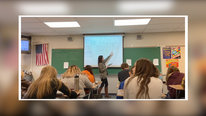- Gwen Stovall
- https://cns.utexas.edu/directory/item/16-molecular-biosciences/1542-stovall-gwen?Itemid=349
- HRI Director and Principal Investigator
- High School Research Initiative
- https://cns.utexas.edu/hri
- University of Texas at Austin
- Deanna Buckley
- Associate Professor of Practice
- High School Research Initiative
- https://cns.utexas.edu/hri
- University of Texas at Austin
- Matt LaDue
- Specialist
- High School Research Initiative
- https://cns.utexas.edu/hri
- University of Texas at Austin
- Jill Rhoden
- HRI Outreach Program Coordinator
- High School Research Initiative
- https://cns.utexas.edu/hri
- University of Texas at Austin
- Ashley Wall
- Facilitator
- High School Research Initiative
- https://cns.utexas.edu/hri
- University of Texas at Austin
Public Discussion
Continue the discussion of this presentation on the Multiplex. Go to Multiplex











Jill Rhoden
HRI Outreach Program Coordinator
Hello, and welcome to the High School Research Initiative page! The University of Texas High School Research Initiative (HRI) is a scientific inquiry center that provides dual-enrollment research courses, trains teachers to successfully lead research/inquiry experiences, as well as provides supportive resources to introduce and lead scientific inquiry experiences in a high school environment.
We are excited to share our program with you and chat about the challenges and highlights of this year of virtual learning!
Gwen Stovall
Catherine McCulloch
Senior Project Director
Gwen and team, it was great to hear from the high school students who were beneficiaries of your program. It sounds like you were able to quickly and successfully adapt your program. What elements, if any, of the remote version of your program might you continue, and why?
Gwen Stovall
Deanna Buckley
Associate Professor of Practice
Hi Catherine,
In addition to what Jill mentioned, we plan to keep the "living slide decks" which include opportunities for students to work collaboratively with technology-supported checkpoints for formative assessment, and are sources of data for social and emotional growth in students over time as well as a measure of equity and inclusive practices for instructors. The hands-on kits are essentially what we would use in a face to face classroom during instruction and we plan to keep those materials too.
Jill Rhoden
HRI Outreach Program Coordinator
Hello Catherine! Great question! We have been envisioning the expansion of the program to schools outside of the Austin area, particularly to rural areas of Texas. The remote access allowed many of our undergraduate peer mentors to visit the high classrooms virtually which meant they could more easily fit this time into their schedule and did not have to worry about transportation. This gave us a glimpse into how we could move forward with virtual peer mentors in future iterations of the program. We also held our fall Student Visit and spring Student Conference virtually. Given the choice, I prefer these events to be in-person for a variety of reasons but the virtual format would allow students and teachers to connect with each other across the state without the limits of travel (time, expense, etc.). Additionally we plan to conduct our summer teacher professional development virtually again which we hope will give attendees more flexibility and greater access.
Ashley Wall
Gwen Stovall
Jaime Gutierrez
Research Associate II
Hi Gwen and team, thanks for sharing! I love the idea of scaling to difficult to reach places and doing this remotely being able to potentially deal with that is great. I'm curious to hear about some of the challenges you faced? Anything that surprised you during this process?
Ashley Wall
Gwen Stovall
Gwen Stovall
HRI Director and Principal Investigator
Wonderful question, Jaime! The virtual environment provided lots of opportunities for innovation! Students needed materials and "equipment" to conduct their experiments and collect data. This need led to the development of science kits, complete with dice, slinkies, pH strips, and more, which could be easily used at home to inspire our ambitious student researchers and provide an opportunity to conduct inquiry experiments. Many of the inquiry activities, some planned, some developed in the moment, will continue into the future. We were pleasantly surprised with what the HRI teachers, staff, and students decided to do with the kits! It seems like they were poised and ready to spring into Scientist Mode when given a few science "toys" (also know as equipment) to play with!
Ashley Wall
Ashley Wall
Facilitator
Great question, Jaime! Those science kits worked really well and got students thinking about the diverse ways they could use materials to conduct experiments. What really impressed me was how creative students were. Many used common and recycled materials from their homes (old golf balls, used tiles, cardboard, etc.). The materials in the kits helped further encourage them to think outside of the box!
Gwen Stovall
Deanna Buckley
Associate Professor of Practice
Hi Jaime,
One challenge for the course is how to accurately measure responding variables for any inquiry students might propose. A slinky and some miniature marshmallows seems an unlikely source for how to teach calibration while measuring weight (and an opportunity to discuss weight vs. mass) but colorful and engaging materials seems to invite participation and creativity.
Ashley Wall
Gwen Stovall
Channa Comer
STEM Educator
Hello Gwen and team,
Thank you for the great presentation. Your students are impressive! I'm curious about how students are selected for the program, their grade level, and whether you follow their progress after they have graduated from high school? Did going virtual make it more challenging to find student participants? How did you facilitate student collaboration?
Gwen Stovall
Jill Rhoden
HRI Outreach Program Coordinator
Hello Channa!
Thank you! We continue to be impressed by our students as well!
In terms of students selection, many of the students self-select or are recruited by our teachers. Some of our schools offer this course as a capstone to their Bio-Med pathway or academy so these students select the course to fulfill this requirement. We have brainstormed and implemented a variety of recruitment efforts such as reaching out to counselors and creating informational flyers for students, teachers, and parents. Most of our students are seniors with a few juniors. Unfortunately we have not followed our students formally post HS graduation but we do hear back from some occasionally!
Our teachers had initially anticipated our highest enrollment yet as we approached the start of the school year but our numbers did drop when the semester actually began. I believe when students had to really prioritize school life and personal life challenges, unfortunately elective courses like this one ended up on their drop list. Despite the drop in enrollment, we still had an fabulous group of students who amazed us with their creativity, perseverance, and effort! Many participated in our Regional Science Festival and three qualified for the Texas Science and Engineering Fair!
Our teachers did an amazing job of keeping students engaged and collaborating. In addition to our teachers, our undergraduate peer mentors were absolutely critical in bridging the connection between student groups and university collaborators. A silver lining to the virtual nature of the course this year was the flexibility for the peer mentors to attend the classes more easily without having to travel from the UT campus to the school campuses. We also held two virtual events that allowed students to meet other HRI students as well as hear from researchers at UT, ask questions of peer mentors, and as well as present their own work!
Ashley Wall
Gwen Stovall
James Callahan
Thank you, HRI team, for your wonderful work and very enjoyable video.
A question, in relation to the pandemic; specifically adjusting programs to be remote and/or virtual.
Which of your kits have adjusted best to the new conditions? What are characteristics of those that do best under virtual conditions? And which are better to wait it out until more normal in-person conditions return.
We want to learn more from you, our dear colleagues.
The Mobile Climate Science Labs very much also brings hands-on STEM to schools and to large STEM events in the local communities. Primarily as labs and demos; secondarily as kits that stay in the schools. With lots of overlap between kits and labs. In adapting to the pandemic, we were able to adjust to meet our goal to now provide remote LIVE Climate Action Labs. The specific characteristic being that Zoom participants are able to take part directly in the live labs remotely. Participating in in the action together, socially.
It was clear that some of our labs (or kits) would work better than others. Those that are very essential-to-hold-in-you-hand-to-be-fun kinetic experiences would loose too much being just visual. Others by contrast, especially those based on invisible infrared light, adjust very well to being remote interactive labs.
Of your well established repertoire of kits, have you decided to bring some more to the forefront, and let others take a bit of a rest during the pandemic? Or are all in play; all working equally well in the virtual meeting environment?
Thank you!
Jill Rhoden
HRI Outreach Program Coordinator
Hello James! Thank you for your question!
We created one kit for our summer teacher professional development that included items that we anticipated our participants needing for the activities that supported the curriculum we were presenting. These items ranged from marshmallows and slinkies to more 'scientific' equipment like measuring tapes and pH strips. The goal was for our participants to have everything handy in a box so that we could use our time efficiently. We did adjust some items that we typically use in the lab for both cost and safety and we modeled what the teachers could expect to have their students do if they remained remote.
A few activities worked out better than expected while others had to be adjusted. Our curriculum involves both group work as students learn about statistics and independent work as they design and conduct their experiments. Some tools that worked well for group assignments included using Google Sheets to create a real-time spreadsheet of student data. Activities that had to be modified were those that required the physical need of an extra pair of hands! At the end of our professional development, we had our teachers assess the usefulness of the components of the kit and make suggestions for other items to add. We were trying to anticipate supplies that students might need to conduct a variety of independent experiments at home like seeds, metal thermometers, pH strips, etc.
I'm looking forward to checking out your video!